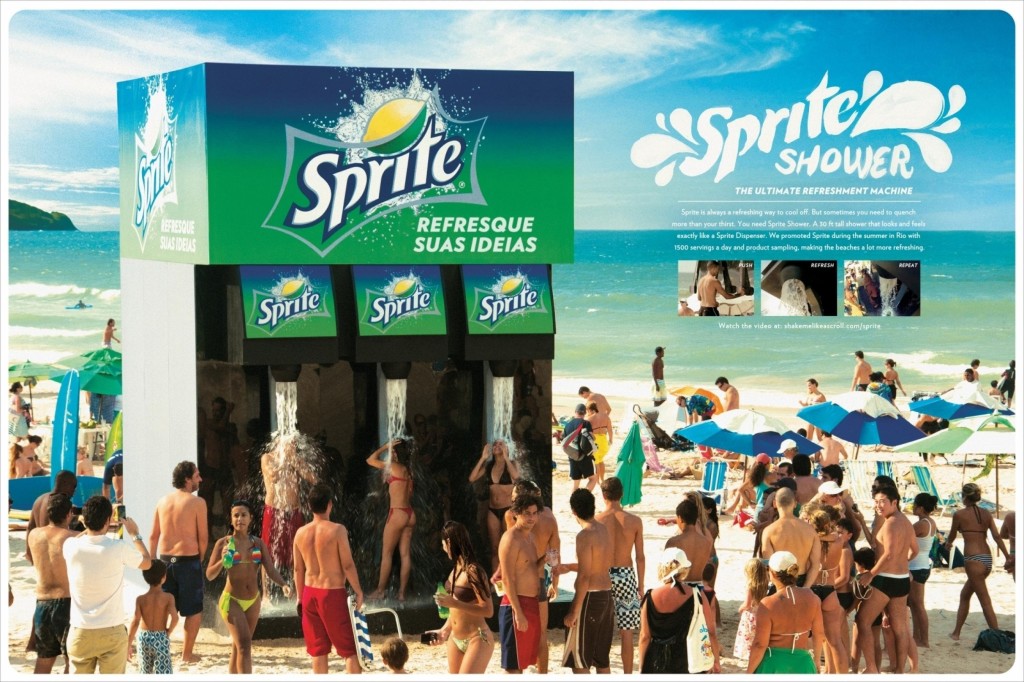Sprite Shower – a great example of experiential marketing (courtesy of Exact Drive)
How do you market a theme park, museum, or holiday resort? Do the traditional 4 Ps of Product, Price, Place and Promotion still work?
The answer certainly lies less in your marketing mix and more in what I’d call your Experience Mix.
What is the Experience Mix?
Unlike traditional products and services, the success of “experience goods” like leisure attractions, restaurants, clubs, restaurants, cafes, malls, and other lifestyle destinations are often heavily dependent on a mix of multiple factors.
These are usually less tangible, more perishable and often heavily dependent on the alchemy of sensorial pleasures and emotional stimulation.
Collectively, I’d call them the Experience Mix which can be defined as follows:
“The Experience Mix is a combination of factors that impact upon your visitors’ experience with your product. It covers every online and physical touch-point – from your website creative and copy, social media posts, offline ads, signages, decor, crew member, merchandise, food & beverage, and more.”
Often experience-rich goods require you to curate and choreograph every customer touch point.
Your goal is to ensure that his or her five senses are receiving the right stimuli while integrating physical, emotional, psychological, communal, intellectual and even spiritual aspects of experience.
What should you then consider to give a positive jump start to the way you develop and market your experience-based business?
Consider the 7 As as you develop and market your experience-rich destinations.
#1 Awareness
It doesn’t matter if you have the best theme park rides in the world or offer the greatest culinary experience if people aren’t aware of it.
Generating awareness requires you to create sufficient buzz about your offering so that customers are keen to seek you out. It is about getting the word out through whatever means possible – be it online or offline.
I’ve probably written more about this than any other topic, so do read my posts on social media and content marketing for a start.
Oh yes, awareness shouldn’t just be measured by your target audiences’ ability to recall your advertisement or a brand. Rather, it should be equated with how well they can appreciate your brand story, and how closely they can identify with what you offer.
#2 Audience-focused
Know who your customers are and what their preferences are like.
What is their preferred language? What kind of visual or audio cues work better to attract their attention? How physically fit and able are they?
In addition, determine how your outlet or surroundings should be furnished to cater to their needs. If your guests are likely to include many elderly folks or young children, you should make provisions for sufficient seats for them to rest at.
#3 Accessibility
Being easily reached, understood and appreciated are key. Here, consider factors like your target audience’s physical, language, and cognitive abilities.
Cultural contexts should also be considered. If the bulk of your guests are foreign, you need to include captions that can be easily understood either in their own language or a simplified form of English.
The level of accessibility determines if your offering catches on quickly or loses its significance due to its inability to strike a chord.
#4 Action-oriented
Focus not only on offering the service, but how you can engage your customers to be part of the action. Are there ways for them to interact with your exhibits? Can they try their hand at making their own dish?
Studies have shown that the more deeply you can involve your guests in the action – both emotional and physical – the higher your chances of delighting them.
Involve them, get their hands all dirty, and let them play!
#5 Amazement
What makes participating in your activity more fun and interesting? How do we make it awe-inspiring and exceptional?
Can you transport your customer to a magical or faraway place? Is there something that will just blow his or her mind away?
In an over-stimulated digitally enhanced world, the only way to stand out is to offer extraordinarily vivid and memorable encounters. To stand out, you need to differentiate yourself from competing demands for a customer’s discretionary time and money.
#6 Affinity
An emotional connection and bonding helps endear yourself to your customers.
Look for the common ground with your target audiences. Ask yourself how the experience conveyed can touch their hearts or make their lives more meaningful? What else can you do to resonate with them?
Find universal themes that everybody can appreciate, and inject the art of storytelling into your museum, park, or restaurant. Disney is a master at this.
#7 Atmospherics
These relate to the environment, ambience and other aesthetic factors that lead to the overall flavour, colour and uniqueness of an experience-rich destination.
How do they contribute to a night at the museum, or a day at the library? Are there distractions like bad smells, broken tiles or peeling walls? Is the music being played conducive or does it sound like a broken record?
What other ideas can you think of? I’d love to hear your thoughts!
This post was inspired by a recent email I sent to Ivan Chew offering 2 cents worth of ideas on marketing. I have rejigged it slightly and expanded on the As for the purpose of this post.


It was really nice to study your post. I collect some good points here. I would like to be appreciative you with the hard work you have made in skill this is great article.
Boutique Public Relation Agency | POP Communications